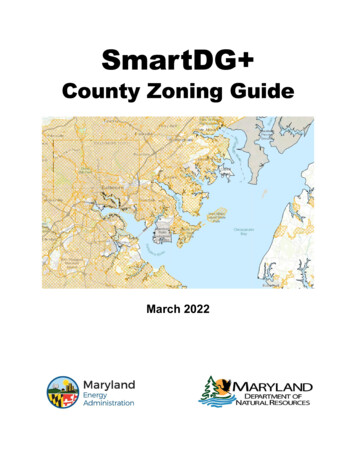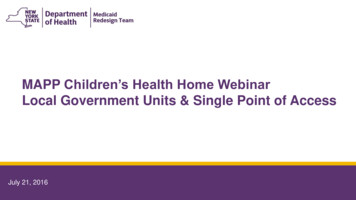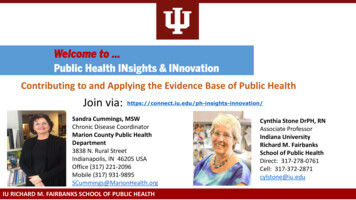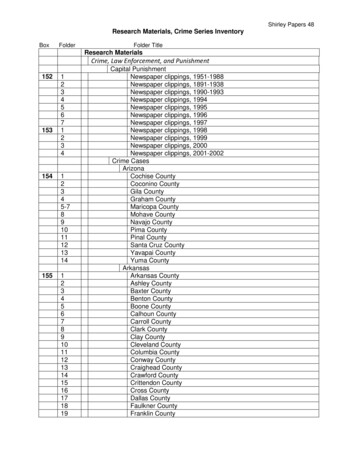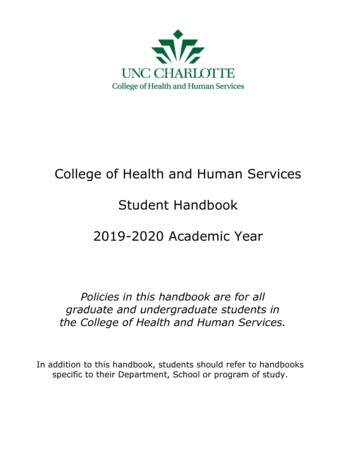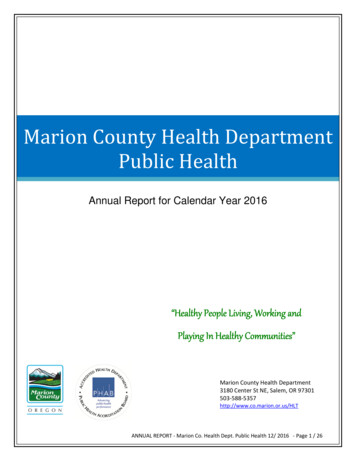
Transcription
Marion County Health DepartmentPublic HealthAnnual Report for Calendar Year 2016“Healthy People Living, Working andPlaying In Healthy Communities”Marion County Health Department3180 Center St NE, Salem, OR TANNUAL REPORT ‐ Marion Co. Health Dept. Public Health 12/ 2016 ‐ Page 1 / 26
Marion County Health DepartmentPublic Health Annual Report – 2016TABLE OF CONTENTSSectionTitleI.Executive SummaryIII.Public Health Program HighlightsIII.IV.Page3 Communicable Disease7 Early Childhood Nursing9 Environmental Health9 Prevention Services10 Public Health Emergency Preparedness11 Reproductive Health12 Women, Infants and Children Supplemental Nutrition Programs12Marion County Health Profiles – Quick facts on topics of interest Mobile Food Units13 Gonorrhea17Quality Improvement – HighlightsQuality Improvement Success Stories19Administrative focus: Mandatory Staff Training20Program focus: Immunizations for Clinic Clients21V.Performance Measures – What are they?22VI.Performance Measures in Action – Communicable Disease Control23VI.Public Health Quick Facts – public health in action24VI.Public Health Quick Facts – the public health system working together24ANNUAL REPORT ‐ Marion Co. Health Dept. Public Health 12/ 2016 ‐ Page 2 / 26
Marion County Health DepartmentPublic Health Annual Report – CY2016Executive SummaryOur Mission as a local public health department is to provide leadership to improve and protectthe health of our communities.Our Vision for Marion County is healthy people living, working and playing in healthy communities.This report highlights our work to implement our mission and achieve ourvision in 2016. The health department continues to maintain itsaccredited status and build on the core processes that enable ourcontinued delivery of quality services to the community.Five core processes or systems help to guide us in our work. Accreditation by thePublic HealthAccreditation Board(PHAB) providesofficial recognitionthat Marion CountyPublic Health meets orexceeds the rigorousstandards designed toimprove and protectthe health of thepublic by advancingthe quality andperformance of thenation’s state, local,Tribal and territorialpublic healthdepartments.Community Health AssessmentStrategic Plan for Public Health ServicesPerformance Management System / Quality ImprovementWorkforce DevelopmentCollaborative Community Health Improvement PlanningThe Marion County Community Health Assessment contains informationabout the health of Marion County residents. It is updated annually andposted on the Marion County Health Department webpage for publicviewing.The Strategic Plan for Public Health Services aligns with and supports theMarion County Strategic Plan strategic goal #6: Health and CommunityServices, Promote the overall health of people in Marion County byimproving the delivery of quality health services and supportingcommunity‐based prevention efforts. In 2014, Marion County HealthDepartment Public Health Division engaged in a planning process toidentify strategic priorities and objectives for the period January 2015‐December 2019. The planning process was informed by local communityANNUAL REPORT ‐ Marion Co. Health Dept. Public Health 12/ 2016 ‐ Page 3 / 26
health data, and planning participants included theMarion County Board of Commissioners, representationfrom the Health Advisory Board, and communitymembers. The four strategic priorities developedthrough this process include: Provide the Five Basic Health Services mandatedby Oregon law (ORS 431.416).Maintain a well‐trained and competent publichealth workforceEstablish and enhance internal and externalpartnerships through collaborationAssure health promotion and disease preventionIn 2016, Marion County Health Department Public Health Division updated the 2015‐2019Strategic Plan to replace goals that had been completed in 2015. A Strengths, Weaknesses,Opportunities, and Threats analysis was conducted with each program team and two new goalswere prioritized for Public Health Division. These goals are tailoring services to clients and publichealth communication and branding. Throughout 2017, each program team will implementstrategies to achieve these goals. Strategic Plan targets reached in 2016 include: completion of aninternal STI program evaluation that informed program changes and improvements; developmentof mission statements by most coalitions convened by Public Health Division; updating and postingthe community health assessment on the internet; and development and distribution of theCommunity Health Improvement Plan.The Strategic Plan, 2015‐2019 is posted on the Marion County Health Department webpage.Performance Management and Quality ImprovementQuality improvement “in public health is the use of a deliberate and defined process,such as Plan‐Do‐Check‐Act, which is focused on activities that are responsive tocommunity needs and improving population health. It refers to a continuous and ongoingeffort to achieve measurable improvements in the efficiency, effectiveness,performance, accountability, outcomes, and other indicators of quality services orprocesses which achieve equity and improve the health of the community.”(Source: Riley et al, “Defining Quality Improvement in Public Health”, JPHMP, 2010, 16(10), 5‐7.)Performance management “is a systematic process aimed at helping achieve anorganization’s mission and strategic goals by improving effectiveness, empoweringemployees, and streamlining the decision‐making process.”(Source: Public Health Foundation, spx)ANNUAL REPORT ‐ Marion Co. Health Dept. Public Health 12/ 2016 ‐ Page 4 / 26
Public Health Division implemented the current Performance Management Plan in January 2015.The plan identifies performance measures and targets that we hope to achieve. Performancemeasures for the 2015‐2019 plan align with the Public Health Division’s mission, strategicpriorities, workforce development plan, community health improvement plan, and program‐Where possible, the measures are paired with community level healthspecific work plans.indicators to make a clear connection between how specific efforts by Health Department staffmay improve the health of Marion County's general population. Each measure is tracked todetermine progress on achieving performance targets. The Performance Management and QualityImprovement plans are strongly linked as measures that underperform significantly will likely leadto a quality improvement project and successful quality improvement projects lead to thedevelopment of a measure to assure we “maintain the gain”.In 2016, we added about 10 program measures to our performance management system. Thesemeasures originated from successful quality improvement projects. However, no qualityimprovement projects were implemented in 2016 as a result of a performance measure notachieving a target.Public Health Division has engaged in formal quality improvement effortssince 2013. Utilizing the Plan‐Do‐Check‐Act framework we havecontinued to conduct various quality improvement projects throughoutprograms, the division, and the department. In 2016 we added qualityplanning to our toolbox allowing us to thoughtfully use data and qualityimprovement concepts to plan and implement processes that do notalready exist. A special effort was made in 2016 to promoteimprovements that required programs to work together to achieve a common goal. Examples of2016 quality planning and quality improvement projects are included later in this document.Going forward, quality improvement projects will continue to be used to address performancemeasures not consistently meeting defined targets and systems problems identified through dailyoperations. A planned focus for 2017 is to increase our efforts to prioritize quality planning orimprovement processes that aim to improve population health.Workforce DevelopmentMaintaining a well‐trained and competent public health workforce is a Marion County HealthDepartment Public Health Division strategic priority. Training and development of our workforceis also one part of a comprehensive strategy toward agency continuous quality improvement.Through the implementation of our Workforce Development Plan for Public Health we promoteboth organizational and individual training. Since 2012, professional public health staff has usedthe public health core competency self‐assessment from the Public Health Foundation to prioritizetheir own annual professional development goal. In 2016, we developed and implemented aANNUAL REPORT ‐ Marion Co. Health Dept. Public Health 12/ 2016 ‐ Page 5 / 26
modified self‐assessment tool for public health peer and support staff. We now have our entirePublic Health Workforce engaged in assessing and seeking ways to improve their knowledge,understanding and application of the public health core competencies. The combined data willprovide a more complete picture to inform public health division group training efforts.Community Health Improvement Plan (CHIP)Marion County Health Department convenes a collaborative partnership to improve the health ofthe community. A new improvement plan launched January 2016. To develop the plan, CHIPpartners participated in the 2015 county‐wide community health assessment, and selected priorityhealth issues for 2016‐2019. Priorities for the new plan are obesity, access to prenatal care,tobacco prevention and depression. These priorities are identical to those for the CHIPs inneighboring Polk County and for Willamette Valley Community Health, the local coordinated careorganization serving individuals on Medicaid. Partners contributing to the Marion County effortthrough leadership and/or collaboration include the three local hospital systems, primary careproviders, community based organizations, local government and higher education.ANNUAL REPORT ‐ Marion Co. Health Dept. Public Health 12/ 2016 ‐ Page 6 / 26
Public Health Program UpdatesThe Public Health Division includes more than 20 individual programs, provided by registerednurses, licensed sanitarians, registered dietitians, certified prevention and health educationspecialists, certified lactation consultants, nurse practitioners, health educators, public healthworkers, nutrition educators and specialists, epidemiologists, a physician health officer,supervisors, and many support staff. In 2015‐2016 MCHD was fortunate to host Public HealthAssociates, who are employees of the Centers for Disease Control, embedded at MCHD to gainentry‐level experience and training from our professional staff. In addition, MCHD programscontinue to partner with universities and host both undergraduate and graduate level internswho will form a vital part of our future public health workforce.Communicable DiseaseThe mission of Marion County Health Department’s communicable disease programs is toprotect the community’s health by preventing and controlling the spread of infectiousdiseases. These goals are accomplished in two ways: Investigate cases of reportable communicable disease to prevent the spread of diseases in thecommunity. The Health Department (MCHD) receives reports for over 60 communicablediseases and conditions from local healthcare providers, labs and hospitals. Staff investigatescases to identify the source of the infection, make sure the patient and exposed personsreceive treatment, and put in place needed measures to protect the general public.Provide specialized public health services to individuals to diagnose, treat or preventcommunicable diseases that are reportable under Oregon law. Provision of these direct services by the local health department varies by county. In Marion services include: Sexually Transmitted Infections Clinic HIV Counseling & Testing Immunizations for adults and children Tuberculosis Treatment and Case Management ProgramANNUAL REPORT ‐ Marion Co. Health Dept. Public Health 12/ 2016 ‐ Page 7 / 26
Highlights for Communicable Disease Services: Communicable Disease Investigation (CDI) – In 2016, CDI responded to 29 communityoutbreaks. About half of the outbreaks occurred in care facilities. Of individuals affected byoutbreaks in 2016 46.2% were infected with Norovirus. Staff also responded to 689 cases ofreportable diseases. The 2016 Reportable Diseases and Conditions Summary provides ratesand information about diseases occurring in Marion County, Sexually Transmitted Infections (STI) – In 2016, rates of reportable sexually transmittedinfections (Syphilis, gonorrhea, Chlamydia) continued to rise. The Health Departmentimplemented measures to decrease gonorrhea by ensuring the public received the righttreatment from their provider. Efforts such as monitoring treatments, and feedback andoutreach to providers reduced the rate of inadequate treatments by 65%. HIV Counseling and Testing From 2012‐2015, Marion County averaged 16.8 new HIV Cases per year. The program’smission is to promote healthy behaviors among population groups at high‐risk for HIV,including regular testing to ensure early diagnosis and treatment of people with HIV. In 2016,the health department provided 459 HIV Tests and education to 256 individuals throughclasses and outreach activities. Among Oregon counties, Marion has the third highest rate ofpeople living with HIV (estimated 444.5 per 100,000). HIV Medical Case Management – A certified HIV Nurse Case Manager provides medicalcase management to about 175 individuals living with HIV/AIDS in Marion County. In July 2016provision of this service transitioned to a community‐based partner organization, HIV Alliance.As HIV Alliance already provided other care, including coordination of dental andpharmaceutical support services, it was felt that clients would benefit from receiving all casemanagement services through one organization. Immunizations – In 2016, MCHD administered fewer overall vaccine doses, but also saw anincrease in unduplicated clients. There has also been an increase in the number of refugeefamilies seeking immunizations at MCHD, especially those with children who need vaccines forschool entry. In 2016, 5626 Immunizations were given including 240 in Stayton and 228 inWoodburn. Staff also coordinates the state school immunization law process for MarionCounty. The percentage of students who received an exclusion order in 2016 was 5.5%. This isslightly higher than normal due to additional immunization requirements for students thatwere implemented beginning with the 2015‐16 school year. Tuberculosis (TB) Investigation and Management – In 2016 there were 4 new casesreported. The TB Program takes the lead on treatment and contact evaluation of all casesoccurring in Marion County, coordinating care with the primary care provider. The majority ofcases require 6‐9 months of treatment including frequent home visits to provide the TBmedications.ANNUAL REPORT ‐ Marion Co. Health Dept. Public Health 12/ 2016 ‐ Page 8 / 26
Early Childhood NursingThe mission of the Early Childhood Nursing Team is to assure that women have healthypregnancies and good birth outcomes and that every child has an opportunity to grow anddevelop to his or her fullest potential. This is accomplished through the provision of no costpublic health nurse services in the home setting to pregnant and parenting women and theirinfants and children. The CaCoon program serves children with special medical issues and thenurse works with the family and providers to facilitate coordination of care. Maternity casemanagement services engage women before delivery.Highlights for Early Childhood Nursing:An unfilled nursing position led to reduced client and home visit numbers. Recruitment ofnurses who are bilingual in Spanish‐English continues to be a challenge for all nursingprograms. The team added a focus on evidence based practices to address State and NationalTitle V Priorities for maternal, child and adolescent public health services.YEAR# HOME VISITS#UNDUPLICATED onmental HealthThe mission of the Environmental Health program is to promote healthy communities thoughinspection and licensing of public venues including, but not limited to restaurants, mobilefood units, pools and hotels. Staff works with state agencies to inspect the National SchoolLunch Program and childcare facilities. They also monitor public drinking water systems;respond to animal bites from rabies susceptible animals; and work with communicabledisease investigation staff to investigate and contain food borne outbreaks.Highlights for Environmental Health:Marion County continues to be the leader among county health departments in certifyingfood service managers. The ServSafe class helps to ensure that each food service’s designatedPerson in Charge will have a good understanding of the principles and practice of safe foodoperating procedures. The latest data available from Oregon Health Authority shows thatMarion County participants accounted for over 50% of those completing the manager testpost training in Oregon in 2015, In 2016 MCHD trained an additional 94 managers.The program also issued 471 food handler cards and conducted over 3800 environmentalhealth inspections.ANNUAL REPORT ‐ Marion Co. Health Dept. Public Health 12/ 2016 ‐ Page 9 / 26
Prevention ProgramsThe mission of the Prevention Team is to promote healthy communities through a variety ofstrategies that prevent health problems before they occur, or before they become serious. Tobacco Prevention and Education Program (TPEP) - Works with community partners,local organizations, local decision makers, and jurisdictions to create and adoptpolicies that decrease tobacco use and exposure to second hand smoke by creatingsmokefree places and decreasing the influence of the tobacco industry; responds tocomplaints and educates about the Indoor Clean Air Act (ICAA), also known asOregon’s Smokefree Workplace Law, on behalf of the Oregon Health Authority, theenforcement agency for the ICAA; and promotes tobacco cessation by offeringresources for the Oregon Tobacco Quit Line. The Marion County Community HealthImprovement Partnership is the advisory committee to the program. Teen Pregnancy Prevention – Works with local school districts and communitypartners to implement “Cuidate”, an evidence‐based curriculum for prevention of teenpregnancy, and provides culturally appropriate teen pregnancy education to youth.Effective July 2017, Marion County no longer receives support for this work. Alcohol & Drug Prevention – Utilizes the science of prevention to reduce alcohol anddrug abuse in our communities and prevent associated problems such as addiction,injuries and chronic illness. Using best practices, the program analyses trend data,makes program recommendations, disseminates information, provide technicalassistance in delivering research based prevention programs, collaborates withcommunity partners, engages law enforcement, supports youth developmentopportunities, and assists Oregon Together coalitions and other communitystakeholders in mobilizing our communities towards positive outcomes. Problem Gambling Prevention – Works with community partners to increaseawareness of the risks associated with gambling behavior, and to decrease rates ofproblem gambling among residents of Marion County. Provides information, trainingand assistance in workplace policy development, delivers classroom presentations andpromotes positive youth activities that increase awareness of youth gambling,participates in state‐level prevention efforts, provides community based education forall ages, and develop resources for the public. Obesity Prevention in Youth – Uses evidence based strategies to increase protectivefactors of obesity and reduce the risk factors that contribute to chronic disease. As akey priority identified by both partners and residents, this program develops strategicpartnerships to increase physical activity, access to healthy foods and promote safe,intuitive and fun ways to increase active transportation and decrease sedentarybehaviors. This program mobilized community partners to gain funding support foractivity trackers for 5th grade students.ANNUAL REPORT ‐ Marion Co. Health Dept. Public Health 12/ 2016 ‐ Page 10 / 26
Prevention Programs continued Woodburn Community Health Initiative (WCHI) ‐ is a Healthy Eating Active LivingCommunity Project that aims to reduce or improve obesity‐related chronic diseaseoutcomes in the Legion Park neighborhood in Woodburn. WCHI implements healthystrategies that increase protective factors and reduces the risk of developing chronicdiseases. WCHI strategies are a prescription exercise program, Zumba classes,Woodburn's Walking group, nutrition and physical activity classes, and installedexercise equipment at Legion Park. Such strategies are possible thanks to thecollaboration of our key partners and funders.Public Health Emergency Preparedness (PHEP)The mission of the Public Health Emergency Preparedness program is to ensure the HealthDepartment has developed and exercised plans, and trained staff to ensure effective provision offour primary Health Department emergency response functions related to: Outbreak response,Environmental Health, Risk Communications and Mass Medication. The program also participatesin collaborative efforts with the local health care, emergency management, public informationofficer systems, and provides training opportunities for community partners.Highlights for Public Health Emergency Preparedness:In 2016 program staff helped design the Marion County Cascadia Rising earthquake exercise.MCHD employees were trained and helped staff the County Emergency Operations Center,during the exercise, coordinated health system support, participated in message developmentand communications, and other support roles. In coordination with the Health DepartmentEnvironmental Health program, PHEP convened a seminar on Rabies and Zika Virus response forlocal veterinarians.MCHD is pleased to announce that one of the PHEP staff was selected to participate in theNational Association of City & County Health Official Roadmap to Ready course. This nationwideprogram trains new preparedness coordinators in best practices for preparing the communityresponse to public health disasters. As an early outcome of this training, MCHD will conduct aCommunity Assessment for Public Health Emergency Response (CASPER) in 2017.ANNUAL REPORT ‐ Marion Co. Health Dept. Public Health 12/ 2016 ‐ Page 11 / 26
Reproductive Health ServicesThe mission of Reproductive Health Services is to ensure individuals of all income levels haveaccess to effective methods of preventing unintended pregnancy. Services provided includeinformation and exams for birth control methods, as well as exams and treatment for sexuallytransmitted infections. The program also provides Oregon Mothers Care (OMC) services whichinclude pregnancy testing, assistance with Oregon Health Plan (OHP) application, scheduling afirst prenatal care appointment, and referral to community resources.Highlights for Reproductive Health Services:2016 saw an approximate 30% decrease in the number of clients seen for Reproductive Healthservices, compared with numbers seen in 2015. Despite the decrease in client numbers, therewas a 10% increase in the placement of 3‐10 year Long Acting Reproductive Contraceptives.The program continues to serve a high number of low‐income and uninsured individuals.Approximately 80% of clients seen had incomes 100% below the federal poverty level, and 77%were uninsured. Through the provision of birth control to prevent unintended pregnancies, anestimated 3.5 million in taxpayer dollars were saved in fiscal year 2016.Women Infant Children (WIC)The mission of the WIC program is to provide public health leadership in promoting the healthand improved nutritional status of Oregon’s families by offering nutrition assistance towomen, infants and children ensuring they receive adequate nourishment, education andassistance during critical growth & development time periods.Highlights for WIC:Marion County’s WIC program received recognition as one of 55 agencies nationwide toreceive a WIC Loving Support Award of Excellence from the United States Department ofAgriculture (USDA). The program was recognized for its successful peer counseling programand community partnerships and was the only Breast Feeding Peer Counseling program inOregon to receive this award.In 2016, the program participated in the WIC Farm Direct Nutrition Program (FDNP), issuing100% of available coupon to clients between June and September. The program encouragesfamilies to purchase locally grown produce, which supports local agriculture and benefits ourlocal economy.ANNUAL REPORT ‐ Marion Co. Health Dept. Public Health 12/ 2016 ‐ Page 12 / 26
Health Profile:Mobile Food Units (Food Trucks) inMarion CountyMarion County Environmental Health Staff must i nspect each mobi le food unit twi ce p er year. Thisreport will hi ghlight the li cens ing proces s, differences i n costs between restaurants and mobil e foodunits , important i nfor mati on abou t Marion Coun ty licensed mobile food units and w hat Marion Coun tyEnvi ro nmen tal Health has do ne to comply with state regulatio ns for mobil e food u nit i nspection s.Helpful Inspection Definitions:“Priority item” means a provis ion in this code whose appl ication contributes di rectl y to the eliminati on,prevention or reduction to an acceptable level , haz ards associ ated with foodborne il lnes s or injury and there isno other provis ion that more directly controls the haz ard.“Priority foundation item” means aprovision i n thi s code whose appli cati ons upports, facil itates or enabl es oneor more pri ori ty i tems. It incl udes an item that requi res the purposeful i ncorporation of specific acti ons ,equipment or procedures by industry managementto attain control of ri sk factors that contribute to foodborneill ness or inj ury such as personnel training, infrastructure or necessary equipment, HACCP pl ans, documentationor record keepi ng, and labeling."Core Item" i ncludes an item that usuall y relates to general s anitation, operational controls, sani tation standardoperati ng procedures (SSOPs), facili ti es or structures, equi pmentdesi gn, or general maintenance.“Close” means to summarily stop the operati on of a food establis hment pursuant to ORS 624.073 and ORS624.370“Mobile Food Unit”‐means any vehicl e that is sel f‐propel led or that can be pulled or pushed down a si dewalk,street, highway or waterway, on which food is prepared, processed or converted or which is used in sel ling anddi spens ingfood to the ulti mate consumer.“Commissary” means a commis sary catering establ ishment, restaurant, or any other place in which, food,beverage, ingredients, containers, or s uppli es are kept, handled, packaged, prepared or stored, and from whi chvendingmachines or mobil eunits are servi ced“Restaurant,” means an establishment:(a) Where food or drink is prepared for consumption by thepubli c;(b) Where the publi c obtai ns food or dri nk so prepared in form or quantity cons umabl e then and there,whether or not i t is cons umed wi thi n the confines of the premises where prepared; or(c) That prepares food or dri nk i n consumable form for serviceoutside the premises whereprepared. “Restaurant” does not mean arail road dining car, bed and breakfast faci lity, intermittent temporaryrestaurant, s easonal temporary restaurant or si ngl e‐event temporary restaurant.“Temporary restaurant” means an establ ishment: (a) That operates i n connection with a publ ic gathering,entertainment event, food product promoti on or other event; and(b) Where food is prepared or served for consumpti onby the publ ic.Definitions from O AR 333‐150‐00003/2016 pg 1ANNUAL REPORT ‐ Marion Co. Health Dept. Public Health 12/ 2016 ‐ Page 13 / 26
Licensing and FeesLicensing Process1. Ope rator s ubmi ts p lan s2. Envi ron mental Heal th revie wsp lan s3. Envi ron mental Heal th app rovespl ans & mai ls ap pro val lette r4. Facil ity pas se s pre‐ open in gin sp ectionRestaurants and mobil e food units undergo the samelicensi ng process but h ave di fferent fees .Ser viceMob ileFeeRestauran t FeePlan Revi ew (1time) 298 529 (new ) 331 (remodel)Li cens e (annual) 208 441‐ 631 (bas ed on # ofseats)Commiss ary PlanReview (1 time) 396N/ACommiss aryLi cens e (annual) 347N/AThere are 4 class es of mobile food units . Each class hasdifferent requirements .R equirement5. Licens e is sue d6 . Firs t u nan nou nced i nsp ectio n‐comp lian ce s ticker po sted i ffacil ity pas ses ins pecti onClass 1Clas s 2Water suppl yvPlumbedhand w as hingvvC lass 4vvvDis hwash ingsinksvvFood prepall owedvvvno rawmeatvrawmeatallowedCookingall owed7. Ins pe cti on s occur tw ice peryear and if nee ded b ased o n acom pla intClass 3Commiss aryrequi redvvvANNUAL REPORT ‐ Marion Co. Health Dept. Public Health 12/ 2016 ‐ Page 14 / 26
Where are stationary foodtrucks located in MarionCounty? (2015 data)11721235121241In 2015, approximately60% of mobile foodunits moved around thecounty from day to dayand 40% set up in onelocation only. Those inone location may looklike buildi ngs due toskirting or decks, butare still mobile withwheels. Since 2010there has been anincrease from 94 to 155mobiles in the county.Top Recorded Violations, 2015RestaurantMobile Food Unit1. Not freq uent enou gh cl eaning o f fo od‐contact‐non potenti ally h az ardous fo ods1. Hot and col d hol ding temp eratures2. Unclean foo d‐contact su rfaces2. Uncl ean food‐contact surfaces3. Hot an d cold holdi ng temperatures3. Han dwashi ng si nk access ibleClosuresYearRestaurantMobile Food Unit20123 Volun tary1 Heal th Department20132 Volun tary1 Voluntary20141 Volun tary020152 Volun tary0Cl osure can b e voluntary or involuntary.Cl osures are made bas ed on risk or theli kel ihood that
Quality improvement "in public health is the use of a deliberate and defined process, such as Plan‐Do‐Check‐Act, which is focused on activities that are responsive to community needs and improving population health. It refers to a continuous and ongoing
